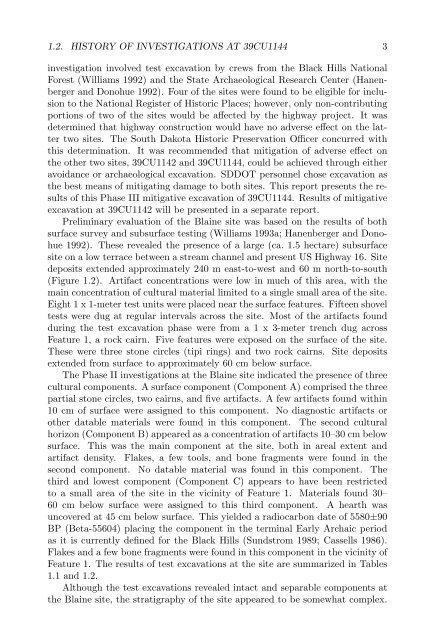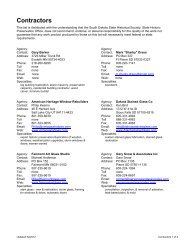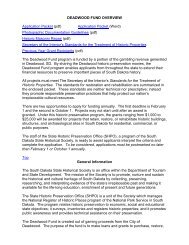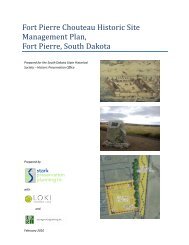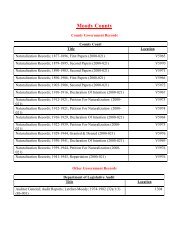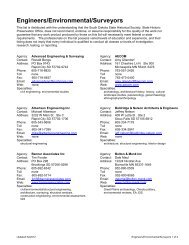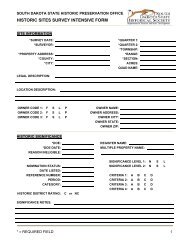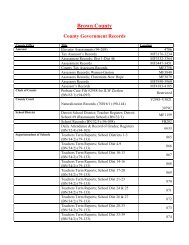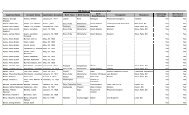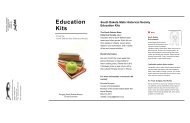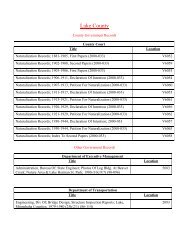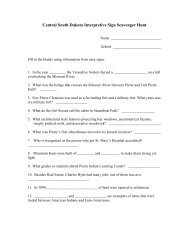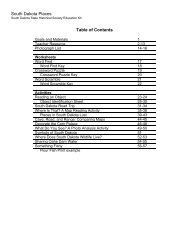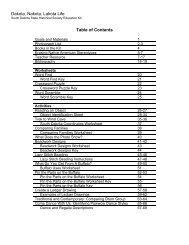The Blaine Site - South Dakota State Historical Society
The Blaine Site - South Dakota State Historical Society
The Blaine Site - South Dakota State Historical Society
Create successful ePaper yourself
Turn your PDF publications into a flip-book with our unique Google optimized e-Paper software.
1.2. HISTORY OF INVESTIGATIONS AT 39CU1144 3<br />
investigation involved test excavation by crews from the Black Hills National<br />
Forest (Williams 1992) and the <strong>State</strong> Archaeological Research Center (Hanenberger<br />
and Donohue 1992). Four of the sites were found to be eligible for inclusion<br />
to the National Register of Historic Places; however, only non-contributing<br />
portions of two of the sites would be affected by the highway project. It was<br />
determined that highway construction would have no adverse effect on the latter<br />
two sites. <strong>The</strong> <strong>South</strong> <strong>Dakota</strong> Historic Preservation Officer concurred with<br />
this determination. It was recommended that mitigation of adverse effect on<br />
the other two sites, 39CU1142 and 39CU1144, could be achieved through either<br />
avoidance or archaeological excavation. SDDOT personnel chose excavation as<br />
the best means of mitigating damage to both sites. This report presents the results<br />
of this Phase III mitigative excavation of 39CU1144. Results of mitigative<br />
excavation at 39CU1142 will be presented in a separate report.<br />
Preliminary evaluation of the <strong>Blaine</strong> site was based on the results of both<br />
surface survey and subsurface testing (Williams 1993a; Hanenberger and Donohue<br />
1992). <strong>The</strong>se revealed the presence of a large (ca. 1.5 hectare) subsurface<br />
site on a low terrace between a stream channel and present US Highway 16. <strong>Site</strong><br />
deposits extended approximately 240 m east-to-west and 60 m north-to-south<br />
(Figure 1.2). Artifact concentrations were low in much of this area, with the<br />
main concentration of cultural material limited to a single small area of the site.<br />
Eight 1 x 1-meter test units were placed near the surface features. Fifteen shovel<br />
tests were dug at regular intervals across the site. Most of the artifacts found<br />
during the test excavation phase were from a 1 x 3-meter trench dug across<br />
Feature 1, a rock cairn. Five features were exposed on the surface of the site.<br />
<strong>The</strong>se were three stone circles (tipi rings) and two rock cairns. <strong>Site</strong> deposits<br />
extended from surface to approximately 60 cm below surface.<br />
<strong>The</strong> Phase II investigations at the <strong>Blaine</strong> site indicated the presence of three<br />
cultural components. A surface component (Component A) comprised the three<br />
partial stone circles, two cairns, and five artifacts. A few artifacts found within<br />
10 cm of surface were assigned to this component. No diagnostic artifacts or<br />
other datable materials were found in this component. <strong>The</strong> second cultural<br />
horizon (Component B) appeared as a concentration of artifacts 10–30 cm below<br />
surface. This was the main component at the site, both in areal extent and<br />
artifact density. Flakes, a few tools, and bone fragments were found in the<br />
second component. No datable material was found in this component. <strong>The</strong><br />
third and lowest component (Component C) appears to have been restricted<br />
to a small area of the site in the vicinity of Feature 1. Materials found 30–<br />
60 cm below surface were assigned to this third component. A hearth was<br />
uncovered at 45 cm below surface. This yielded a radiocarbon date of 5580±90<br />
BP (Beta-55604) placing the component in the terminal Early Archaic period<br />
as it is currently defined for the Black Hills (Sundstrom 1989; Cassells 1986).<br />
Flakes and a few bone fragments were found in this component in the vicinity of<br />
Feature 1. <strong>The</strong> results of test excavations at the site are summarized in Tables<br />
1.1 and 1.2.<br />
Although the test excavations revealed intact and separable components at<br />
the <strong>Blaine</strong> site, the stratigraphy of the site appeared to be somewhat complex.


